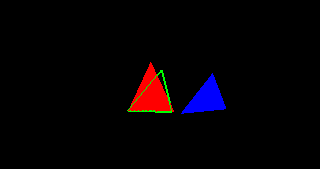As the other comments suggested you most likely got confused withing projections and goniometrics. There is also safer way without goniometrics using vector math (linear algebra).
-
create transform matrix
m0representing aligned plane to first trianglet0by aligned I mean one of the edges of triangle should lie in the one of the plane basis vectors. That is simple you just set one basis vector as the edge in question, origin as one of its point and exploit the cross product to get the remainding vectors.
so if our triangle has points
p0,p1,p2and our basis vectors arex,y,zwith originothen:x = p1-p0; x /= |x|; y = p2-p0; z = cross(x,y); z /= |z|; y = cross(z,x); y /= |y|; o = p0so just feed those to the transform matrix (see the link in bottom of answer)
-
create transform matrix
m1representing aligned plane to second trianglet1its the same as #1
-
compute final transform matrix
mconvertingt1tot0that is simple:
m = Inverse(m1)*m0
Now any point from t1 can be aligned to t0 simply by multiplying m matrix by the point. Do not forget to use homogenuous coordinates so point(x,y,z,1)
Here small C++/OpenGL example:
//---------------------------------------------------------------------------
double t0[3][3]= // 1st triangle
{
-0.5,-0.5,-1.2,
+0.5,-0.5,-0.8,
0.0,+0.5,-1.0,
};
double t1[3][3]= // 2nd triangle
{
+0.5,-0.6,-2.1,
+1.5,-0.5,-2.3,
+1.2,+0.3,-2.2,
};
double arot=0.0; // animation angle
//---------------------------------------------------------------------------
void gl_draw() // main rendering code
{
int i;
double m0[16],m1[16],m[16],x[3],y[3],z[3],t2[3][3];
glClear(GL_COLOR_BUFFER_BIT | GL_DEPTH_BUFFER_BIT);
glDisable(GL_CULL_FACE);
glEnable(GL_DEPTH_TEST);
glMatrixMode(GL_MODELVIEW);
glLoadIdentity();
glTranslated(0.0,0.0,-10.0);
glRotatef(arot,0.0,1.0,0.0);
// render original triangles
glBegin(GL_TRIANGLES);
glColor3f(1.0,0.0,0.0); for (i=0;i<3;i++) glVertex3dv(t0[i]);
glColor3f(0.0,0.0,1.0); for (i=0;i<3;i++) glVertex3dv(t1[i]);
glEnd();
// x,y,z = t0 plane basis vectors
vector_sub(x,t0[1],t0[0]); // x is fisrt edge
vector_one(x,x); // normalized
vector_sub(y,t0[2],t0[0]); // y is last edge
vector_mul(z,x,y); // z = cross(x,y) ... perpendicular vector to x,y
vector_one(z,z);
vector_mul(y,z,x); // y = cross(z,x) ... perpendicular vector to z,x
vector_one(y,y);
// m0 = transform matrix representing t0 plane
m0[ 3]=0.0; for (i=0;i<3;i++) m0[ 0+i]=x[i];
m0[ 7]=0.0; for (i=0;i<3;i++) m0[ 4+i]=y[i];
m0[11]=0.0; for (i=0;i<3;i++) m0[ 8+i]=z[i];
m0[15]=1.0; for (i=0;i<3;i++) m0[12+i]=t0[0][i];
// x,y,z = t1 plane basis vectors
vector_sub(x,t1[1],t1[0]); // x is fisrt edge
vector_one(x,x); // normalized
vector_sub(y,t1[2],t1[0]); // y is last edge
vector_mul(z,x,y); // z = cross(x,y) ... perpendicular vector to x,y
vector_one(z,z);
vector_mul(y,z,x); // y = cross(z,x) ... perpendicular vector to z,x
vector_one(y,y);
// m1 = transform matrix representing t1 plane
m1[ 3]=0.0; for (i=0;i<3;i++) m1[ 0+i]=x[i];
m1[ 7]=0.0; for (i=0;i<3;i++) m1[ 4+i]=y[i];
m1[11]=0.0; for (i=0;i<3;i++) m1[ 8+i]=z[i];
m1[15]=1.0; for (i=0;i<3;i++) m1[12+i]=t1[0][i];
// m = transform t1 -> t0 = Inverse(m1)*m0
matrix_inv(m,m1);
matrix_mul(m,m,m0);
// t2 = transformed t1
for (i=0;i<3;i++) matrix_mul_vector(t2[i],m,t1[i]);
// render transformed triangle
glLineWidth(2.0);
glBegin(GL_LINE_LOOP);
glColor3f(0.0,1.0,0.0); for (i=0;i<3;i++) glVertex3dv(t2[i]);
glLineWidth(1.0);
glEnd();
glFlush();
SwapBuffers(hdc);
}
//---------------------------------------------------------------------------
I used my own matrix and vector math hope the comments are enough if not see:
For info about the matrices and you will find the sources and equations for the math used there too. Here preview for my test case:
Where red is t0 triangle blue is t1 triangle and green is the m*t1 transformed triangle. As you can see no need for goniometrics/euler angles at all. I rotate the stuff by arot just to visually check if the green triangle really align to the blue to prove me I did not make a silly mistake.
Now its unclear how exactly you want to align, so for example if you want maximal coverage or something either try all 3 combinations and remember the best or align to closest or largest edges of both triangles etc …
